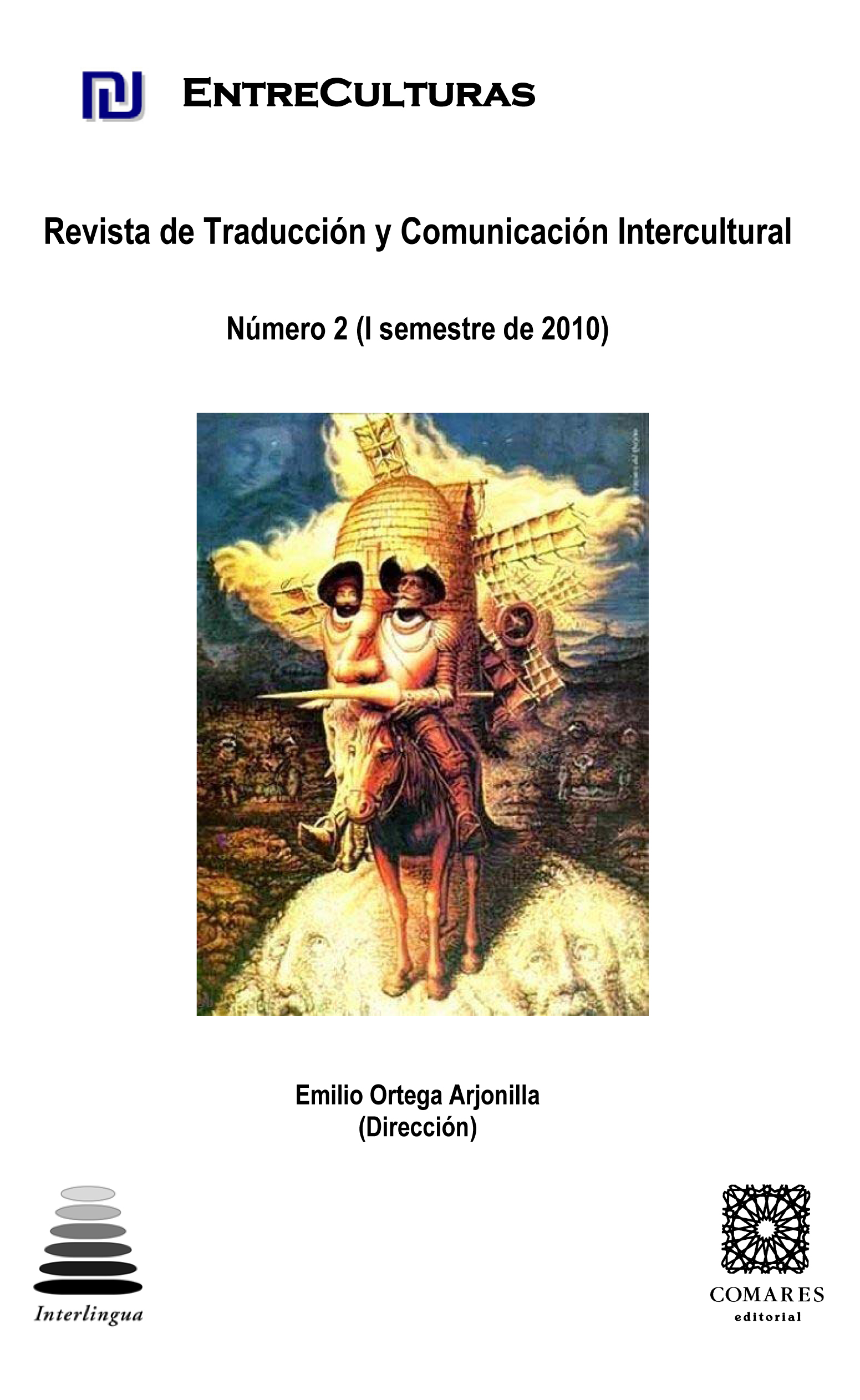GLOSARIO TERMINOLÓGICO Y FRASEOLÓGICO TRILINGÜE (INGLÉS-FRANCÉS-ESPAÑOL) SOBRE FORMULARIOS DE COOPERACIÓN JUDICIAL INTERNACIONAL EN MATERIA PENAL
DOI:
https://doi.org/10.24310/Entreculturasertci.vi2.11768Keywords:
Glossary, Terminology, Phraseology, Form, Judicial Translation, European Judicial Space, European Judicial NetworkAbstract
This paper aims to offer a terminological and phraseological compilation, in the form of a trilingual glossary (English-French-Spanish), extracted from the analysis of four forms of international judicial cooperation from the European Judicial Network (namely, European arrest warrant, Request of information extracted from the criminal record, Freezing order, and Model agreement on the establishment of a Joint Investigation Team), as well as a brief preliminary foray into the most common characteristics of this type of documents and of judicial translation.
Downloads
Metrics
References
ALCARAZ VARÓ, Enrique (2002): El inglés jurídico. Barcelona, Ariel (colección Derecho).
— y HUGUES, B. (2002): Legal Translation Explained. Manchester, St. Jerome Pubishing (colección Translation Practices Explained).
BARCELÓ MARTÍNEZ, Tanagua (2010): De testamentorum translatione. Traducción de testamentos franceses al español. Tesis doctoral [inédito]. Universidad de Málaga.
BOCQUET, Jean-Claude (2008): La traduction juridique: fondement et méthode. Bruselas, De Boeck (colección Traducto).
BORJA ALBI, Anabel (2000): El texto jurídico inglés y su traducción al español. Barcelona, Ariel (colección Ariel Lenguas Modernas).
FERIA GARCÍA, Manuel. (1999): Traducir para la justicia. Granada, Comares (colección Interlingua, n.º 9).
LOBATO PATRICIO, Julia (2008): Aspectos deontológicos y profesionales de la traducción jurídica, jurada y judicial. Málaga, Servicio de Publicaciones e Intercambio Científico [CD-ROM].
— (2009): “La traducción jurada, diferencias con la traducción jurídica y judicial”. Cadernos Eborenses. Revista Internacional de Traduçao, Linguística e Literatura, n.º 1: 421-438.
MAYORAL ASENSIO, Roberto (1997): “La traducción especializada como operación de documentación”, Sendebar, 8-9, 137-153.
— (2003a): “Investigación en traducción jurada” en García Peinado, M. Á. y Ortega Arjonilla, E.: Panorama actual de la investigación en Traducción e Interpretación. Vol. II. Granada, Atrio, 457.
— (2003b): Translating Official Documents. Manchester, St. Jerome Publishing (colección Translation Practices Explained).
— (2004): “Lenguajes de especialidad y traducción especializada. La traducción jurídica”, en Gonzalo García, C. y García Yebra, V. (eds.): Manual de documentación y terminología para la traducción especializada. Madrid, Arco Libros, 49-71.
ORTEGA ARJONILLA, Emilio (2005): “La traducción jurídica, jurada y judicial: aspectos teóricos, metodológicos y profesionales” en Borja Albi, A. y Monzó Nebot, E.: Traducción y mediación en las relaciones jurídicas internacionales. Castellón, Universitat Jaume I de Castellón.
— (2004) (dir.): La traducción e interpretación jurídicas en la Unión Europea. Retos para la Europa de los ciudadanos. Granada, Comares (colección Interlingua, n.º 75).
PARRA, JAVIER L. (2008): “La interpretación y traducción en el ámbito de la cooperación judicial de la UE” en Ortega Arjonilla (dir.): La traducción e interpretación jurídicas en la Unión Europea. Retos para la Europa de los ciudadanos. Granada, Comares (colección Interlingua, n.º 75).
SAN GINÉS AGUILAR, Pedro y ORTEGA ARJONILLA, Emilio (eds.) (1997): Introducción a la traducción jurídica y jurada (inglés-español). Granada, Comares (colección Interlingua, n.º 2).
ŠAR?EVI?, Susan (1997/2000): New Approach to Legal Translation. La Haya, Kluwer Law International.
THIRY, Bernard (2009): Terminología y Derecho. Granada, Atrio.
REFERENCIAS BIBLIOGRÁFICAS EN SOPORTE ELECTRÓNICO
AMUTIO GÓMEZ, Miguel Ángel (ed.) (2007): La construcción de los servicios paneuropeos de Administración electrónica. Madrid, Ministerio de Administraciones Públicas (catálogo general de publicaciones oficiales). www.csi.map.es/csi/pdf/documento_web_IDABC.pdf
DUEÑAS JIMÉNEZ, Valentín (2006): “El Registro Europeo de Antededentes Penales” en Muñoz de Morales Romero, M.; Arroyo Zapatero, L. A. y Nieto Martín, A. (coord.) (2006): La orden de detención y entrega europea. Ciudad Real, Universidad de Castilla-La Mancha, 187-194. http://portal.uclm.es/descargas/idp_docs/doctrinas/duenas_def.pdf
HACIA UNA ESTRATEGIA EUROPEA EN MATERIA DE E-JUSTICIA (JUSTICIA EN LÍNEA) [Comunicación de la Comisión al Consejo, al Parlamento Europeo y al Comité Económico y Social Europeo] http://eurlex.europa.eu/LexUriServ/LexUriServ.do?uri=com:2008:0329:fin:es:pdf>
Downloads
Published
How to Cite
Issue
Section
License
All contents published in Entre culturas. Revista de traducción y comunicación intercultural are protected under the Creative Commons Attribution-NonCommercial-ShareAlike 4.0 International (CC BY-NC-SA 4.0) license. All about this license is available in the following link: <http://creativecommons.org/licenses/by-nc-sa/4.0>
Users can copy, use, redistribute, share and exhibit publicly as long as:
- The original source and authorship of the material are cited (Journal, Publisher and URL of the work).
- It is not used for comercial purposes.
- The existence of the license and its especifications are mentioned.
There are two sets of authors’ rights: moral and property rights. Moral rights are perpetual prerogatives, unrenounceable, not-transferable, unalienable, imprescriptible and inembargable. According to authors’ rights legislation, Entreculturas. Revista de traducción y comunicación intercultural recognizes and respects authors moral rights, as well as the ownership of property rights, which will be transferred to University of Malaga in open access. The property rights are referred to the benefits that are gained by the use or the dissemination of works. Entreculturas. Revista de traducción y comunicación intercultural is published in an open access form and it is exclusively licenced by any means for doing or authorising distribution, dissemination, reproduction, , adaptation, translation or arrangement of works.
Authors are responsable for obtaining the necessary permission to use copyrighted images.





7.png)
